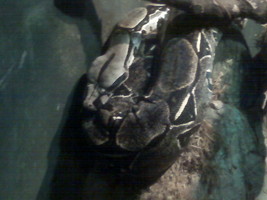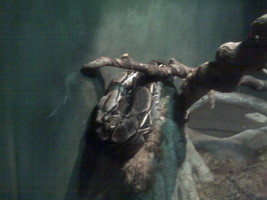Boa constrictors are powerful snakes and sneaky hunters. They live in rainforests throughout most of Central and South America, where they hunt at night. These snakes, like their cousins, the anacondas, are not poisonous. Instead, boas grab and hold onto their prey with their tail. Then they wrap their bodies around it and constrict, or squeeze tightly, until the animal they’ve caught can no longer breathe. The snake swallows its prey whole. It does not use its teeth to chew. Instead, food is digested by strong stomach acids. After a large meal, a boa does not have to eat again for weeks! An adult boa usually weighs around 30 to 60 pounds and grows to about 13 feet. The longest boa constrictor ever found was 18 feet! The boa constrictors are cold-blooded.
Boa constrictors are seasonal breeders. When female boa constrictors are ready to mate, their body gives off a smell which attracts male boa constrictors. Mother boas give birth to about 30 babies at a time! A baby boa is on its own from the start. It is born with the instinct, or built-in knowledge, of how to hunt. It also has an instinct to hide to stay safe from predators.
The bigger it gets, the bigger its preferred prey becomes. It may start out eating mice and other small animals. As it grows, the boa enjoys eating large lizards. Boas are classified as reptiles.
Boa constrictors are not endangered but they are common. However, they might become endangered as they are hunted for their colorful skin. Boa constrictors' colors and patterns may vary. They match the habitat where they live so they can blend in. They can be tan, green, or yellow, but they are usually tan with dark-brown color. The patterns on their bodies can be jagged lines, ovals, diamond shapes, or circles. Boa constrictors spend some of their time in trees. They are excellent climbers.
=D
Information on the Internet
- Boa constrictor Fact Sheet Smithsonian National Zoological Park. Accessed 20 Oct. 2008
- Boa constrictor National Geographic. Accessed 20 Oct. 2008





 Go to quick links
Go to quick search
Go to navigation for this section of the ToL site
Go to detailed links for the ToL site
Go to quick links
Go to quick search
Go to navigation for this section of the ToL site
Go to detailed links for the ToL site